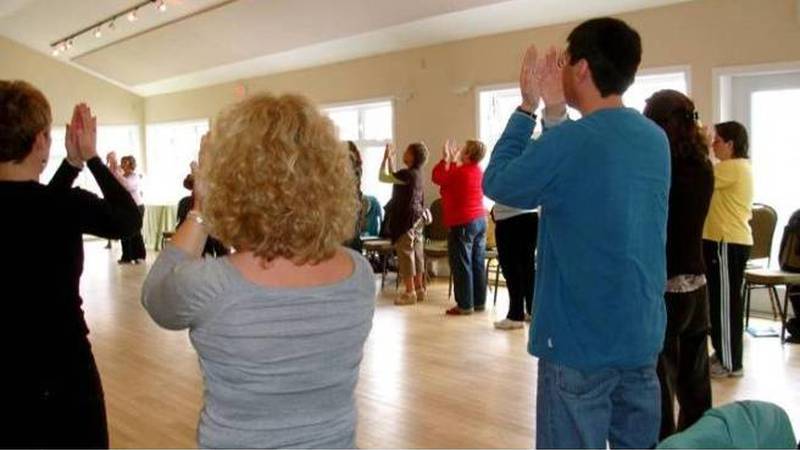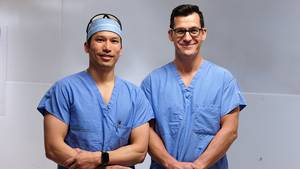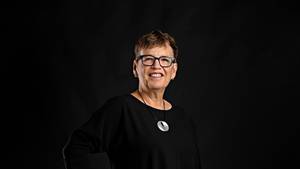For Helen Tupper, art is much more than a fun pastime or hobby. The bright watercolour and acrylic landscapes the Halifax-based artist creates provide a respite from the almost daily pain that intrudes her life.
Tupper has been dealing with pain for more than 40 years. A back injury and subsequent double spinal fusion left her unable to continue her career as a registered nurse.
“Art helps me escape my pain,” she says. “If I can get in four hours of painting, that’s a good day for me. It gives me a sense of accomplishment.”
It also provides her with a measure of pain relief, a remedy that comes as no secret to the staff at the QEII Health Sciences Centre’s Pain Management Unit. The unit has been using art therapy as part of an arsenal of unconventional pain management therapies, including acupuncture, meditation and Chinese exercises such as Qi Gong and Tai Chi. Those pioneering efforts have been met with much success.
“Pain is complex,” says Dr. John Clark, an anesthesiologist and the director of the Pain Management Unit. “If there was one pathway to the brain we could deal with it with one treatment. But pain reaches the brain through many pathways and that’s where it gets complicated.”
Most people are well aware of the human body’s capacity to manage pain. Tales abound of athletes who finish a gymnastic routine or score a goal despite being in the throes of a painful injury, or ordinary people who ignore extreme pain in stressful situations. Complex neurotransmitters — endorphins and endocannabinoids — that the body produces naturally are highly effective at controlling pain. Finding ways to switch on the body’s pain control system is one of the keys to pain management.
That’s precisely what the pain unit staff focuses on doing. June Trenholm is a physiotherapist who leads patients through a detailed pain self-management program designed to help them learn to control their chronic pain in natural ways.
The self-management program she leads relies on a network of healthcare experts including doctors, nurses, occupational therapists, psychologists, vocational counsellor, dietitians and others. June instructs patients in the art of Tai Chi, Qi Gong and a host of other pain management strategies.
“Educating the patient about pain is an important step in changing how safe they feel with movement. We focus on teaching them to move in an efficient and safe way, so that they feel less threatened by the pain and they are able to do more,” explains June. “It is important to find activities and goals that have meaning for them. Pacing their activities so they don’t flare up is necessary for sustainable progress.”
“We’re seeing changes in patients today that we wouldn’t have seen 20 years ago.”
Shari Vogler joined the pain management team as a nurse two and a half years ago. Along with her other duties, she often serves as a source of information for pain sufferers, directing patients to everything from the nearest warm public pool to sources of medication funding.
“It is wonderful when patients try to help themselves…often they want to increase their physical activity with things like dance classes,” says Shari. “So I did some research and found a dance class that someone with chronic pain could participate in. That’s the thing that’s most important; that people living with chronic pain achieve some health and a quality of life.
“If we can reduce someone’s pain by 30 per cent and they start getting some joy out of life, then we’re OK with that.”
Most people tend to think of pain as a symptom of some other problem — a problem that can be treated with drugs, surgery or other therapies. Instead, the unit treats pain as a disease — a disease that has many negative side effects, including mood disturbances, poor sleep patterns, anxiety and a diminished quality of life.
Dr. Clark says one in five people suffer from chronic pain; it’s a staggering number, one that speaks to the massive need for clinics like the QEII’s Pain Management Unit. About 600 new patients come to the unit for treatment every year, with a further 1,200 on the waiting list.
Helen has tried many treatments to relieve her own pain, including acupuncture, cortisone injections and therapeutic exercises, all with some degree of success.
She’s found ways to turn her experiences to the positive, working with other chronic pain sufferers through support groups and serving as president of the Canadian Pain Coalition and the Chronic Pain Association of Canada. She’s also spearheaded the development of National Pain Awareness Week in Canada.
She says the most important thing for chronic pain sufferers is not to suffer alone.
“You can feel like you’re dropping into an abyss when you don’t know where to turn. That’s what makes the QEII’s Pain Management Unit so important in so many people’s lives.”








